THE HISTORY
OF ARGYLE
An original, comprehensive and thoroughly researched account of Plymouth Argyle Football Club from its earliest roots to the present day.
Important copyright conditions:This chapter is licenced under a Creative Commons Licence. Attribution must include the Author (Steve Dean) and this site's address (www.greensonscreen.co.uk) and must be displayed prominently, in close proximity to any associated material, and be implemented with strict regard to the licence conditions.
Parts too small for comfortable reading? Most browsers allow you to zoom. Try Ctrl+ (hold down the Ctrl
key, then press the +
key, without Shift).
Ctrl- reduces the size.
Have you new material to offer? Please get in touch by writing to Steve using the 'Contact Us' button at the top-right of the page.
Photos used on this page: Greens on Screen is run as a service to fellow supporters, in all good faith, without commercial or private gain. I have no wish to abuse copyright regulations and apologise unreservedly if this occurs. If you own any of the material used on this page, and object to its inclusion, please get in touch using the 'Contact Us' button at the top-right of the page.
THE HISTORY OF ARGYLE
An original account of Plymouth Argyle Football Club from its earliest roots to the present day
This is a printed representation of one chapter of GoS's History of Argyle (www.greensonscreen.co.uk/argylehistorymenu.asp), provided for ease of reading and personal retention. Inevitably it lacks links to associated pages, including match and player records, and its layout has been simplified to allow page breaks. Note also that Greens on Screen's online History of Argyle will be updated and new material added from time to time.
COPYRIGHT: the strict conditions for use of this printed version are the same for the corresponding online page, as specified on that page.
Chapter 19: 1953-1957
From Best to Worst, via Hollywood
After one of Argyle's most successful seasons ever, hopes were high that the First Division was in the club's sights. How wrong could they be.
Author: Steve Dean
Version: 1.2
Date: 13 Jul 2020
In this chapter: The summer of 1953 ... 1953-54: Division Two reality ... Summer tour of the USA ... 1954-55: Another fight for Division Two survival ... 1955-56: Third time unlucky ... 1956-57: The third tier for the third time
THE SUMMER OF 1953

Alex Govan, PAFC 1946-1953
After a record-equalling finish for the club - fourth in the second tier - hopes were high that the First Division was just around the corner. However, the end-of-season optimism took a knock in the last week of June when it was announced that one of the club's best players, Glasgow-born Alex Govan, had joined fellow Division Two side Birmingham City. His departure came as a complete surprise, although it later emerged that talks had been taking place for two months. Govan had spent seven seasons at Home Park and whilst he had taken some time to establish a regular first team place, he had been a vital part of the 1951-52 promotion side and then in the record-equalling team the following season. The left-winger's burst of speed and whipped-in crosses from the byline had made him a firm favourite, as did his goals from the wing. Having just turned 24, Govan went on to play for five seasons for Birmingham, three in the First Division, and was a member of their 1956 FA Cup Final side.
Govan left Birmingham in March 1958 for a short spell with First Division Portsmouth, and later that year returned to Home Park for two more seasons before hanging up his boots in 1960. He remained in Plymouth until his death in 2016, six days short of his 87th birthday. However, his spirit lives on: when on the Birmingham coach as it approached Highbury for the FA Cup quarter-final against Arsenal in March 1956, he broke into song with Harry Lauder's 'Keep Right On to the End of the Road'. The rendition was heard by Blues' supporters, who sang it at Hillsborough in the semi-final and at the Wembley final. It became the club anthem, still heard at St Andrews today.

One of the new floodlights, seen for the first time at a pre-season practice match
The summer of '53 also saw two significant changes to Home Park. The tarpaulins that could be lowered over the open ends of the newly built grandstand proved to offer little protection in the wind and rain, so short extensions to the grandstand structure were built to support solid cladding. But the most significant development that close season was the erection of floodlights in the four corners of the ground. Each scaffold-like tower was supported by a concrete base and steel 'guy-ropes', with 16 high-powered lamps at the top. Their purpose was to allow income-raising floodlit friendly games against First Division opposition throughout the season, although over the following five seasons, overseas sides were the usual visitors. The first floodlit game at Home Park was a Reserves' Combination Cup match against Bournemouth and Boscombe Athletic on Monday 28th September 1953, attracting a crowd of 8,250. After the game, Argyle's chairman, Alderman Sir Clifford Tozer praised the 88 kilowatt illumination as "quite remarkable and very attractive".
The floodlights' official switch-on came four Mondays later, but dreadful weather resulted in crowd of just 2,050 for the friendly match against Exeter City, which Argyle won 3-1. Home Park's first Football League game under lights came in December 1956, with the first pylons replaced by more permanent structures in 1958.
1953-1954: DIVISION TWO REALITY
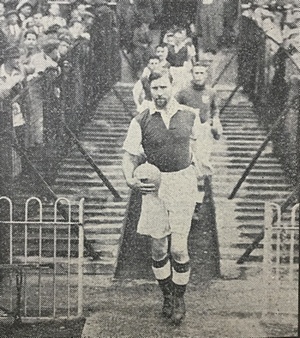
Jack Chisholm leads his side out on a warm summer's evening for the first game of the season
The new season began as never before or since, on a weekday. At 6.15 pm on a Wednesday evening, just a few weeks after the coronation of Queen Elizabeth II, Argyle began with what appeared to be a straightforward home game against a young Bury side, but the Pilgrims managed only a point. A three-goal defeat at Nottingham Forest three days later set the scene for a difficult start to the season. Five of the first six home games ended in a draw, the other a defeat. Overall Jimmy Rae's men managed just one win (at Swansea) in their first 12 games.
By early October the Home Park faithful had yet to celebrate a win, but in predictable fashion the first home victory came with the visit of the division's leaders, Everton. And what a resounding win it was: 4-0 (two goals in each half) in front of a crowd of 26,148, Home Park's best for the season. But what those delighted fans didn't know was that they had just witnessed the final game for another Home Park favourite.

Gordon Astall, PAFC 1948-1953
'Flash' and 'Cannonball', Gordon Astall's nicknames, conveyed the style of the right-winger: pace and power. His strong physique enabled him to storm past defences and either deliver a hard cross at head height or crash in a shot. He had another weapon in his armoury: his strong arms could hurl the ball from a throw-in into the middle of the goalmouth and cause confusion in many a defence.
Service with the Royal Marines brought Astall to Plymouth and to Argyle's attention in 1948. Six days after that win against Everton, Astall joined his former team-mate on the other wing at Birmingham City, and once again the deal came suddenly. It was reported that he did not want to go at first, but was persuaded by the offer of a new house. Whilst with the Midlands club, for whom he made over 200 League appearances, Astall won two full England caps, was chosen for the Football League representative side and, like Govan, played for Birmingham in the 1956 FA Cup Final (along with future Argyle captain, Johnny Newman).
The win against Everton proved once again to be the exception rather than the rule, and by mid-November Argyle found themselves just one point off a relegation place, although two consecutive wins then eased the pressure. In the second, a 3-2 win at Blackburn, the referee adjudged that that an Argyle attempt had crossed the line, even though a Rovers' defender had dived to scoop the ball out with his hand. After consulting a linesman. the referee then changed his mind and instead awarded a penalty, which Argyle missed. Thankfully it did not affect the result.

The programme for the extraordinary defeat at Goodison Park
That pair of wins in November proved once again to be the exception, with only two further victories before the last week in March. The stand-out game in those winter months was the return fixture with Everton on 27th February 1954, which was also manager Jimmy Rae's 300th game in charge. The Toffees were on the same number of points as three others at the top of the table, but had an inferior goal average, even though they had scored 12 in their last two games.
The result was one of the worst in Argyle's history: an 8-4 trouncing in front of a crowd of 44,496. Snow had fallen the previous night and the surface must have contributed to the scoreline, but according to reports, Argyle put on a decent show, especially going forward. The Pilgrims were actually 2-1 up after 12 minutes and at half time the score was a creditable 3-2 to the home side. As the game went on, Everton's fast, accurate passing undid the visitors, but Argyle took heart from scoring four goals against a top side.
Perhaps the afternoon was best summed up by the Liverpool Post: "Any team which can score four goals away from home is unlucky to lose...Plymouth's defence was cut and carved as though by a razor...Yet they put up a bonny fight. Some of their attacking ideas were sound...There was an abundance of good football and not all of it was played by Everton." Everton, incidentally, won promotion at the end of the season.

Neil Langman, PAFC 1953-1957
Two of Argyle's goals were scored by 22-year-old centre-forward Neil Langman, who was making his debut for the first team. Neil, the younger brother of reserve team centre-half Peter, signed from local side Bere Alston as a part-time professional earlier in the season, whilst also continuing his apprenticeship with the South West Electricity Board. He was described as having "the physique and face of a heavyweight boxer" and he certainly made an big impact in the remaining weeks of the season, scoring nine goals in nine games, including a hat-trick at the Baseball Ground when Argyle beat Derby County 4-1 near the end of March.
After the official switch-on of the new floodlights back in October, the club staged three floodlit friendlies in the 53-54 season, including the crowd-pulling visit of FA Cup holders Blackpool on the Monday before the Derby game. The First Division side, Stanley Mathews and all, were thoroughly outplayed, Argyle winning 4-1 in front 25,090 excited fans. Two further floodlit friendlies had been scheduled but these were cancelled because of Argyle's perilous position, one off bottom of the table.
The Pilgrims remained in a relegation place for the next four weeks, and by Easter there were four games to go and survival at stake. On Easter Saturday, Argyle were winning 3-0 against fellow strugglers Brentford with ten minutes to go, but two goals in a minute from the visitors, who were desperate themselves to pick up points, meant a thrilling end to the game. Argyle held firm, and as turned out, another win on Easter Monday would almost certainly see the Pilgrims safe.
Easter Saturday was tense but the Monday game ended with high drama and huge relief. Argyle had picked up a point at Upton Park on Good Friday (yes, three games in four days), with the return fixture at Home Park on Easter Monday. West Ham took the lead after 74 minutes, and with three minutes remaining, Tony McShane gave the fans hope. Then in the dying seconds, left-half Johnny Porteous, an almost ever-present that season, ran through to strike what was described as the goal of the season. The fans went wild, throwing their hats in the air. As beautifully described in a newspaper report, "Argyle players raced up to shake Porteous' hand warmly and patted him on the back. Paddy Ratcliffe was so excited he picked up his shy team mate and carried him half-way up the field in triumph. Within seconds the final whistle sounded, and Jack Chisholm hoisted Porteous up and chaired him bodily off the pitch to the delight of the crowd who, in three minutes, had gone from abject despair to delirious delight."
Argyle were safe. They picked up one more point in the two meaningless games that remained, ending the season fourth from bottom, three points above a relegation place. Huge relief after a campaign that was in stark contrast to the record-equalling season before.
SUMMER TOUR OF THE USA
At the end of the 1923-24 season, Plymouth Argyle embarked on a pioneering tour of South America (described in Chapter 13). Thirty years later the club crossed the Atlantic Ocean for a second time, on this occasion to the United States of America for a 25-day coast-to-coast ten-match tour. Accompanied by two directors, Mr Edgar Dobell and Mr Bob Heath, manager Jimmy Rae and trainer George Taylor took a squad of 15: Jack Chisholm, Jimmy Crawford, Malcolm Davies, Neil Dougall, Ernie Edds, Pat Jones, Neil Langman, Les Major, Sam McCrory, Tony McShane, Arthur Morgan, Johnny Porteous, Paddy Ratcliffe, George Robertson and Bill Shortt.
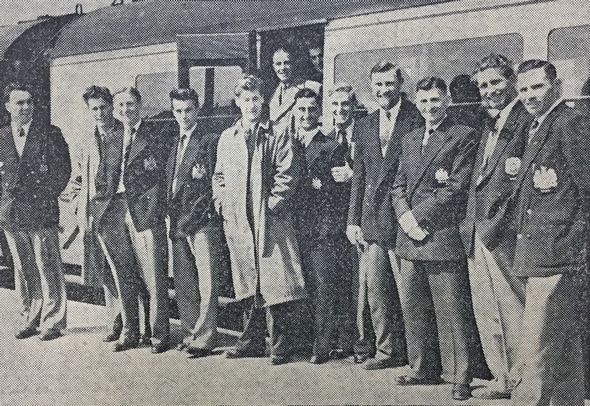
The team gather at Plymouth North Road railway station for the trip to Doncaster. They returned to Plymouth six weeks later.

A typical cabin on SS Ile de France, where some of the players spent a lot of time, flat out.
Remarkably, the players hardly had time to clean their boots before setting sail. A week after the dramatic Easter games, Argyle played their final match on the original fixture list, at Doncaster on Saturday 24 April. But a game postponed in February meant there was one more to play, at 6 pm on Monday 26th at Stoke City. What a dash it must have been to get to Southampton Docks for the sailing of SS Ile de France the following evening. Ahead of them lay over 6,000 miles on-board ship and approximately 5,000 in the air. In all they were about to travel the distance in six weeks that they usually travelled in a typical season of eight and a half months.
George Taylor, Argyle's trainer, sent back a weekly account of the tour, and in it he described a difficult outward journey. Most of the party suffered the effects of the rough seas, which sometimes crashed over the promenade deck, with the big men, Jack Chisholm and Neil Langman, being particularly affected. As well as excitement, there must have been huge relief when six days later they were able to pick out Ellis Island, the Statue of Liberty and the New York skyline.

Argyle's travels across America, flying west (in green) from New York to Chicago, St Louis, Denver, and Los Angeles. Then by coach to San Francisco before flying again (in blue) to Chicago, Detroit, Philadelphia and finally back to New York.
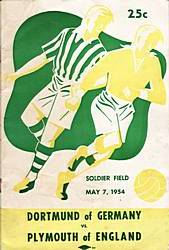
After a night in the Paramount Hotel, Times Square, the party set off on the first leg of their 25-day tour of the States: a flight to Chicago, Illinois. The Pilgrims were unexpectedly met at the airport by James B. Cook, the President of the Kloster Steel Corporation, who played 15 times for Argyle in the 1908-09 season before emigrating to become a steel worker soon after.
Three days later, on Friday 7th May, Argyle met Borussia Dortmund in a match that was billed by their American hosts as "the greatest international match ever staged". The Germans were also touring at the time and as their first game in the USA, it was certainly a baptism of fire for the men in green. The venue was Soldier Field, an impressive 100,000 all-seater American football stadium. There were problems though: the pitch was 120 yards long and 58 yards wide (Home Park was about 100 x 75) and the penalty area was drawn out 12 yards from goal rather than 18. There was little that could be done about the overall dimensions but the start was delayed to allow the penalty areas to be remarked. The match ball was also found to be too small and soft, so a ball at Argyle's hotel was sent for. Under floodlights and with continuous commentary over loudspeakers, around 12,000 spectators watched Dortmund thoroughly deserve their 4-0 win. Afterwards, Jimmy Rae expressed his disappointment with his team's sluggish performance, but six days of seasickness must have had an affect.
The following day the team flew the 260 miles to St Louis, Missouri. A day later, Sunday 9th May, they met St Louis Simpkins, a team described by 'Spectator' in the Western Independent as the best in the United States. The result was an emphatic 8-4 win for the Pilgrims, with Neil Langman scoring six. Then came an 800-mile flight to Denver, Colorado to meet Colorado All Stars on Thursday 13th. The venue was the Denver baseball ground, where goalposts of any form were not normally required, so wooden posts with feet were made rather than sinking them into the ground, and the crossbar fitted into slots at the top of each post. As for the game, at half-time the score was 10-1 to the visitors, the rout ending up at 16-2 (this time it was Sam McCrory's turn to bag six). Of course the inevitable happened too: play was delayed when Ernie Edds hit the crossbar and the whole structure collapsed. There are no records that span over 130 years of competitive and friendly matches, but this is probably the highest number of goals that an Argyle first team has ever scored in a game.
The next leg of the journey, on Friday 14th May, was an 830-mile flight from Denver to Los Angeles. The tour schedule allowed for six days in the capital of make-believe, including two matches but also time to enjoy the sights and glamour. The first game, on Sunday 16th May, was another encounter with Borussia Dortmund, and this time hopes were high. In the previous week, Argyle had scored a total of 24 goals against six and had surely shaken off the effects of the Atlantic Ocean, even though they had travelled the breadth of America since then. The L.A. public was buzzing, with one report saying that Hollywood was as excited about seeing a British football team as the tour party was about seeing Hollywood. The game at Wrigley Field attracted a crowd of 15,000, including many film stars, and, as in Chicago, three national anthems were played ahead of kick-off. However, Dortmund were once again too strong, although the scoreline, 1-3, was an improvement. Nevertheless, referring to the German side's fine all-round display in both games, Jimmy Rae said, "We shouldn't have been able to beat this team in 50 years."
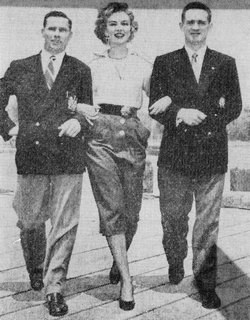
Paddy Ratcliffe and Neil Dougall with Hollywood actress, Kathleen Hughes
On Wednesday 19th May the players enjoyed a tour of Hollywood's Paramount Film Studios, where they met stars of the silver screen and were treated to first class hospitality. The second game in L.A. was played later that day at the Rancho La Cienega Stadium, against Los Angeles All Stars (called Los Angeles Scots in one report). Argyle won the game 2-0 in front of about 3,000 spectators, with the modest scoreline mainly due to the performance of McCauley, an ex-Scottish League player, in the home side's goal.
Early the following day, Thursday 20th May, the tour party headed north to San Francisco, but this time the journey was by coach. Around 11 hours later the weary travellers were greeted once again by the local football officials, before meeting the Mayor of San Francisco the following morning (described as 'a very jovial fellow'). Friday and Saturday were spent sightseeing, including a tour that provided spectacular views of the Golden Gate Bridge and Alcatraz Island. The sixth match of the tour was played on Sunday 23rd, against San Francisco All Stars, a team that included six Mexicans. It was a tough game in which the All Stars equalised twice, but Argyle managed the decider for a 3-2 win. In his report, trainer George Taylor said that the Pilgrims had taken things far too easily and that the All Stars took the honours. Unfortunately, an abdominal injury after a wild challenge meant that Pat Jones would not be able to play on the remainder of the tour. Also at that time, Bill Shortt was loaned to Chelsea, who were visiting the States and Canada, for the remainder of the trip because Chelsea's only goalkeeper, Bill Robertson, had had an urgent appendix operation. (Argyle had a second 'keeper, Les Major, in their tour party.) Robertson travelled with the Argyle party for the rest of the tour in Shortt's place, and Chelsea promised a friendly game at Home Park later in the year as compensation.

The team began their journey east just 24 hours later, starting with a gruelling 1,900-mile, eight-hour flight back to Chicago, where they played the first of four games in their final eight days of the tour: an 8-1 win over Chicago All Stars at the Shewbridge Stadium. (Curiously called the Shrewbridge Stadium on the programme cover.) One of the first to welcome the Pilgrims to Chicago was Eugene Melaniphy, the manager of the Chicago soccer side, who scored 32 times in 69 games for Argyle between 1932 and 1936. Then it was on to Detroit, although not without incident: the plane was forced to fly through a violent thunderstorm, described by George Taylor as "like being tossed about like a cork in a rough sea".
Waiting for them in Michigan's largest city was Argyle's chairman, Sir Clifford Tozer, who had flown over to join the party at the end of his year as Lord Mayor of Plymouth (his second time; he was also Lord Mayor 23 years earlier). Whilst there, the tour party were shown around the Plymouth Motor Works, a plant capable of producing 2,800 cars per day. ('Plymouth' was a popular car brand in the States.) On Saturday 29th May, Argyle beat Chicago Polish Falcons (also called Chicago League Champions) 6-1 in Detroit, and immediately after the game, headed for the airport and a 500-mile flight for an overnight stop in New York. The following morning they travelled 60 miles to Philadelphia by coach, where they beat Philadelphia All Stars 3-2 that afternoon, just 24 hours after their game in Detroit.
The final game of the tour, two days later on June 1st, was back in New York, where they beat the American All Stars XI 1-0, a team largely composed of ex-English and ex-Scottish League players. With the temperature around 30 degrees Celsius (in the 80s Fahrenheit) as it had been for much of the tour, and with so much travelling, the players must have been exhausted.
On June 3rd the Argyle party and Chelsea's recovering goalkeeper boarded SS Flandre for the journey home. As they watched the New York skyline drift into the distance, they no doubt reflected on what must surely have been the experience of a lifetime. From the bright lights of Times Square to San Francisco's Golden Gate, the American welcome was exceptional. Hungry press and TV crews followed their every move and hardly a day had gone by without a banquet for the boys from Plymouth, England. The team was often given a police escort, sirens and all, that the players couldn't quite believe, which prompted their driver in San Francisco to remark that he had not experienced such a journey, with cars pulling over as Argyle's transport travelled through, since President Eisenhower's visit. Unfortunately it was back to reality, and the seas on the journey home were as rough as the month before, which was very bad luck for the Chelsea 'keeper, whilst Bill Shortt enjoyed a flight home with his temporary teammates a few days later.

On board the SS Flandre for the return to Plymouth after the experience of a lifetime. Between leaving Southampton on April 27th and arriving in Plymouth on June 9th, Argyle's touring party had travelled some 14,000 miles by sea, air and land.
Back row: Jimmy Crawford, Pat Jones, Ernie Edds, Malcolm Davies, Jimmy Rae, Ship's Captain, Arthur Morgan, George Robertson, Tony McShane, George Taylor
Front row: Paddy Ratcliffe, Neil Dougall, Sam McCrory, Les Major, Jack Chisholm, Neil Langman, Johnny Porteous
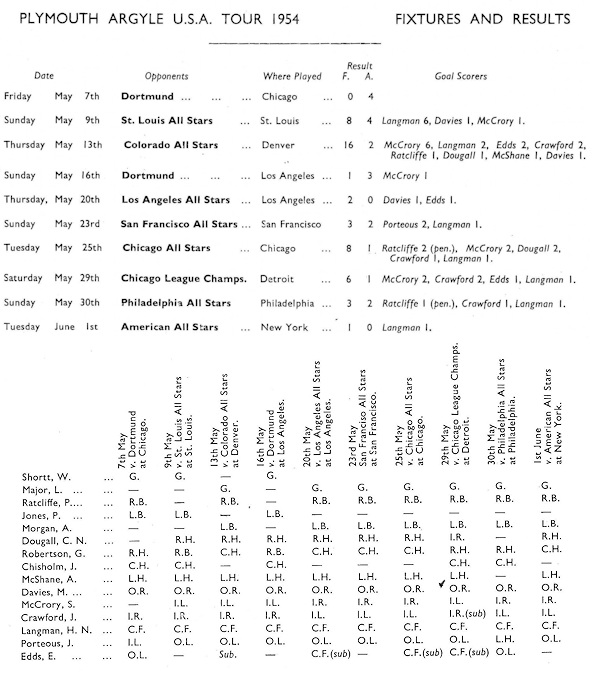
The full details for the 10 matches and 15 players, as listed in the PAFC Handbook 1954-55
1954-1955: ANOTHER FIGHT FOR DIVISION TWO SURVIVAL

A cartoon in a local newspaper, joking about the hard work ahead after weeks of good living.
Two directors, the manager, trainer and 15 players returned home to their families six weeks after leaving them for their penultimate game of the season at Doncaster. They had enjoyed the trip of a lifetime, but back home, little had changed. Argyle had finished two points and two places off relegation after a season of struggle, and despite the talk of a wondrous time abroad, fans saw little reason for optimism. Off the field, there were signs of discontent amongst shareholders, which grew as the months passed and as the financial losses from the previous season emerged. In September, Mr Dudley Coles resigned from the board and another director, Mr Heath, probably the most active of all board members and one of the USA tour party, was not re-elected in a stormy shareholder meeting.
On the field, not only were there no new faces over the summer, but in August it emerged that Jack Chisholm needed surgery on a knee after a pre-season training incident. Big Jack had had knee operations before and it seemed likely that yet another was not good news. The surgery at Mount Gould Hospital to remove another section of cartilage and a fragment of bone was successful, but a long period of recovery was inevitable. In his place, Tony McShane was made captain.
The first two games of the new season were both at home and, coincidentally, against the two teams relegated from the First Division and whom Argyle had never played before. The opener was against Middlesbrough and the season was only 12 minutes old when Argyle's 'keeper, Les Major, was carried off the field. Paddy Ratcliffe went in goal for a full half-hour before Major reappeared with five stitches in his head, to great applause. Remarkably Ratcliffe had kept a clean sheet and at half-time the ten men were 1-0 up. The game ended at 2-2; under the circumstances it was a creditable draw. Two days later, 34-year-old Bill Shortt deputised for Major against Liverpool, the second relegated side, and this time the Pilgrims did even better: a 1-0 win despite a first half injury to young left-back Arthur Morgan, which left him limping as a left-wing passenger for much of the game.
It was an encouraging start, especially without the inspirational Chisholm at the back, but sadly the injury list lengthened over the following weeks, forcing Argyle to field an increasingly inexperienced side. Only six points were picked up in the next 15 games: one win, four draws and ten defeats, and the win in early October was helped by one of the strangest own-goals ever seen at Home Park. Argyle beat Fulham 3-2 but their first was down to Fulham's goalkeeper, Frank Elliott. In the 16th minute, whilst lying near the penalty spot after a heavy fall and clearly in distress, Elliott threw the ball away, only for it to trickle over the line and nestle against the net.

One of the strangest own-goals ever seen at Home Park
Clearly dazed and in pain, Elliott was stretchered off but returned eight minutes later. Left-winger Charlie Mitten, father of future Pilgrim John Mitten, had taken his place for those eight minutes, but at half-time the Fulham manager decided that Mitten should go back in goal for the second half, with Elliott hobbling on the wing (later it was discovered that the goalkeeper had broken a wrist). Reports praised Mitten for his heroic display but he was unable to prevent Argyle's winner with 15 minutes remaining, scored by captain Tony McShane, his last goal for the club. So yes, Argyle had won a game, their first victory in nine, but it was by a difference of one goal, effectively playing against ten men for most of the game with an outfielder between the posts, and the benefit of a goal thrown in by the visitors' goalkeeper.
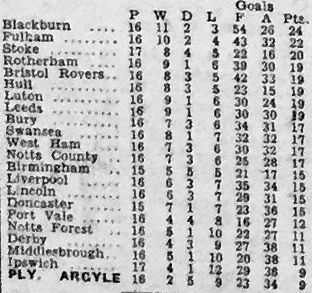
The Second Division table on 7 November 1954
The season had started so well, but injuries, bad luck and increasing friction between the board and the shareholders were the ingredients of a downward spiral. After the extraordinary win against Fulham, Argyle lost six games in a row and found themselves at the foot of the table in November, but two wins in a fortnight helped them to climb to one off the bottom at Christmas.
The Monday night Floodlit Friendly programme, launched in 1953, continued in October with games against Newcastle United and Chelsea, both from the First Division. The Newcastle game on Monday 4th October followed the Magpies league fixture at Cardiff 48 hours earlier, and over 11,000 Argyle fans were delighted to witness a 3-2 win over their top-flight opposition. A fortnight later, Chelsea fulfilled their promise made in America to play a game at Home Park, but there was no fairy-tale ending this time. Chelsea scored four and had two more disallowed in the first half-hour, and then took their foot off the pedal out of respect for their hosts. The final score was 1-5, but there was some consolation: Chelsea ended the season as Football League Champions.
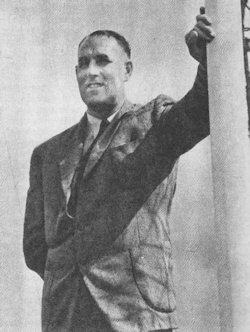
Jimmy Rae in happier times
Newcastle returned to Home Park in early January, this time for the much more serious third round of the FA Cup. Nearly 30,000 fans were eager to see well-known names like Jackie Milburn, Bob Stokoe and Jimmy Scoular, but it was the Pilgrims who rose to the occasion and were unlucky to lose by the only goal of the game to the side that went on to win the FA Cup that year.
The glamour tie was over and it was back to the struggle for Second Division survival. Then, less than a fortnight later, came the news that took everyone by surprise: Jimmy Rae had resigned. In a reference to the boardroom and shareholder turmoil, Rae explained, "Everybody knows that I supported the section of the Board that has been deposed. It's only natural I shall have to go."
It was the end of a 23-year association with Plymouth Argyle Football Club that began when he travelled from Aberdeen as a player in 1932. He became a regular left-back over the following seven seasons until war intervened. In 1945 he became Jack Tresadern's assistant manager in the hugely challenging years after the war and then took over as manager in 1947. His eight years in charge included a relegation, a promotion and a season that equalled the club's all-time best position.
Unsurprisingly, George Taylor was given the caretaker role and two days later he was celebrating a win, 1-0 at home to Derby County, the Pilgrims' first victory in eight games. A week later came the worst defeat of the season, 6-1 at West Ham United. Neil Langman's older brother, Peter, made his first team debut that day, having played patiently in the Reserves for four years. Despite the heavy defeat, Peter Langman retained the centre-half shirt for the rest of the season. A week later, Taylor selected Maurice Tadman for his seventh game of the season. It was to be the 33-year-old's 253rd and last appearance for Argyle, having scored 112 goals in eight seasons at the club. That scoring record left Tadman in third place in the all-time goals-scored ranking at that time, behind Sammy Black and Jack Leslie, and he has only slipped two places since (overtaken by Wilf Carter and Tommy Tynan).
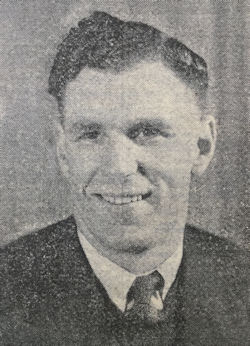
Jack Rowley, Argyle's new player-manager
George Taylor's temporary tenure lasted 28 days. On Thursday 17th February 1955, 37-year-old Jack Rowley joined the club as the first player-manager since Robert Jack's first spell in 1905. Rowley had spent 17 years with Manchester United, scoring 211 goals in 424 appearances (over 500 matches if you include the war leagues), and he remains to this day the Red Devils' all-time fourth highest goalscorer, one place ahead of George Best and only beaten by Wayne Rooney, Bobby Charlton and Denis Law. It was quite an appointment and the impact was immediate. Two days after his arrival, Argyle chalked up the first away win of the season and the first of three wins in a row, something that had not been achieved for two years. After the first two of those wins, both away, a bumper and enthusiastic crowd came to Home Park to enjoy a home win for only the second time in three months and to welcome Rowley as the club's saviour. It was quite a start and by the end of the season, quite a contrast: five wins in the 30 matches before his arrival and seven wins in the remaining 13 games.
Those three wins in a row lifted the club to one place above the relegation places, but a disruptive injury list returned and the two remaining months were tense. By mid-April bottom-placed Derby County's fate was all-but settled but the second relegation place was still in doubt; it would be either Argyle or Ipswich Town. With three games to go, Argyle beat Ipswich at Home Park to give the Pilgrims real hope, but a defeat followed and it was down to the last day of the season. Thankfully the Pilgrims beat Stoke City and Ipswich lost on that final Saturday, and Jack Rowley was hailed a hero.
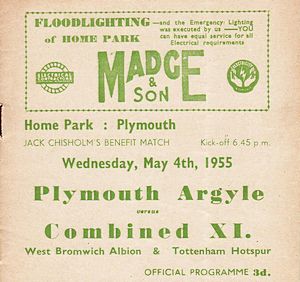
The season was over but there was one more game to be played. A selection of players from West Bromwich Albion and Tottenham Hotspur came to Plymouth for Jack Chisholm's benefit match, which Argyle won 3-2 on the Wednesday after the final league match. Jumbo Jack's recovery from his knee operation at the start of the season had been long and frustrating for all concerned, and his presence had been sorely missed - not so much for his ball skills but as a captain, leader and motivator. In February he turned out for Argyle Reserves at home to Fulham, where one of his best qualities, calling out and waving his arms to organise his young teammates, was a reminder of what the first team had missed, but it was clear that his mobility, never his strong point, had been badly affected. In atrocious weather, nothing could stop Big Jack from wearing his number five shirt on his benefit night but that was his last time in green, 11 months after his last game for the senior side, in Philadelphia, Pennsylvania.
There is more about Jack Chisholm in Chapter 17.
1955-1956: THIRD TIME UNLUCKY

Training, 1955-style
In an attempt to inject fresh blood into Rowley's selection options, the directors placed six players on the transfer list over the summer: Tadman, Edds, Dews, McCrory, McShane and Tom McArthur, who had been signed as a potential successor to Jack Chisholm, but played just once. Amongst many attempts to strengthen the squad, often failing through a lack of funds, two newcomers arrived: right-half Crawford Clellend from Aberdeen and left-half Ralph Wetton from Tottenham Hotspur, the latter impressing for the combined West Brom and Spurs side in Jack Chisholm's testimonial a few weeks earlier. To form a brand new half-back line, centre-half Trevor Lawless was promoted after only two games for the Reserves, and was even made captain for the start of the season. Sadly the rise proved too much for him; after eight games in the first few weeks the part-time pro (he was also a teacher at Crownhill Secondary Modern) never played for the senior side again.
For the second year in a row, Argyle's first game was against a team relegated from the First Division. This time it was a heavy 5-2 defeat at Sheffield Wednesday, whose dominance was engineered by England international inside-forwards Albert Quixall and Jackie Sewell. (The British football transfer record was broken in March 1951 when Sewell joined Wednesday from Notts County for £34,500.) If fans were shocked by the scale of the result, they weren't to know that Wednesday would end the season as Division Two champions. Two days later Argyle opened their home programme with 2-2 draw against Doncaster Rovers, but new boy Ralph Wetton did not make an ideal start; he was sent off after a goalmouth fracas after 65 minutes, along with the Doncaster inside-right. It was the first time in Wetton's career that his name had gone into a referee's book.
Argyle's first win came at the start of September: a 1-0 victory at Hull City, who were to end the season at the bottom of the table. On the following Monday, a 1-0 defeat at home to Stoke City was marred by a tackle in the 35th minute which caused Peter Anderson to be stretchered off with a double broken leg. Argyle were effectively down to nine men for the second half when Ralph Wetton was forced to limp on the left-wing after sustaining an injury. Inspired by the manager, who was playing with a heavily strapped fractured wrist, the Pilgrims put Stoke under constant pressure but the visitors held out. A disappointing defeat, but 21,000 fans cheered their team off the field for their rousing performance. As for Plymouth-born Anderson, his season was over in early September but he recovered to become an important player for Argyle in the years ahead.

The first home win came at the end of that week, 1-0 against Blackburn Rovers, and making his debut was Dockyard apprentice Johnny Williams. This was his first of 447 matches over the following 11 years, in which he deservedly earned the accolade of a true Argyle great.
Unfortunately, five straight defeats followed. The run was not helped by an unsettled side because of a string of injuries, with the manager forced at times to try players in unfamiliar positions to fill the gaps.
But perhaps the main reason was Jack Rowley's determination to change the style of play and that took some time to bed in. When Rowley arrived in the final months of the previous season, the focus was wholly on survival by whatever means, but for this new campaign, he wanted to encourage the more sophisticated style of play that he was used to in the First Division. The goalkeeper was encouraged to throw the ball to a full-back, and the players then to pass the ball upfield on the ground rather than 'hoofing' it. Inevitably the tactic broke down in the early weeks, and consequently there were some very poor goals conceded. After the pre-season belief that a fresh start with a first class manager meant an exciting season ahead, Argyle fans, not used to the style, were initially frustrated and impatient, and "Kick it!" became a common cry from the terraces.
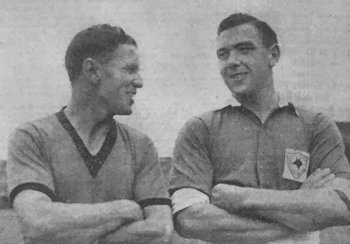
The Rowley brothers, Jack and Arthur
The third of those five defeats was a home match against Leicester City, whose inside-left was Jack Rowley's younger brother, Arthur. Unfortunately it was Arthur who put one over on his big brother by scoring the winning goal. Incidentally, Arthur Rowley, six years younger than his brother, ended his playing career on 434 goals from 619 League games, a record for the English Football League that still stands today.
The five consecutive defeats were followed by a draw and then, on 22 October, a very welcome win at Barnsley. The manager scored both goals, the second being an impressive milestone: it was Jack's 200th career League goal. Incredibly, brother Arthur reached his double century on that same afternoon, although with Arthur also scoring two that day, accounts differ as to which brother reached the 200 mark first.
With Hull City firmly rooted to the bottom of the table, Argyle struggled to break free from the next-to-bottom spot that they had occupied since late September, although a 4-3 home win against Leeds United in mid-November reduced the gap. At centre-half for Leeds that day was 20-year-old Jack Charlton, the great man's first of four visits to Home Park in his 21 years and 773 appearances for Leeds, an all-time club record. Jack and younger brother Bobby will of course be best remembered for their England careers and as World Cup winning heroes in 1966. Incidentally, Bobby graced Home Park on one occasion, when Argyle beat Preston North End 2-1 in March 1975. Playing for Preston in the twilight of his career, Bobby scored the equaliser in the 85th minute (his final goal in English football), only for Paul Mariner to grab the winner three minutes later.

Western Independent, November 1955
At the end of November the gap was widened again by a 4-1 defeat at home to Bury, who were also struggling. Argyle were five points adrift in the two relegation places, and bearing in mind that those were the two-points-for-a-win days, the gap could be thought of as seven in today's terms. The real problem was a lack of firepower, and pressure increased on the board to go out and buy, but lack of money was a continuing problem. In a formal statement at the beginning of December, chairman Sir Clifford Tozer said, "The Board realise the seriousness of the club's place in the League and are determined to do their utmost to retain Second Division status. Team strengthening entails considerable expense. Today, £5,000 is a small fee and probably £15,000 would be a minimum figure required to sign a player of the experience and standard required. Players of that quality are not generally available, and even if the money is forthcoming, the player quite rightly has the last word in the transfer deal. Unfortunately Argyle are not able to pay high fees and the Board unanimously agree that every effort will be made to build up a team of youth mingled with players of experience. Meanwhile, the greatest service to the club at present can be given by supporters attending the matches and thereby helping Argyle's revenue."
The board's plea to fans did not receive wholehearted support: a very welcome two points came in December with a convincing 4-0 win at home to Middlesbrough, but the attendance of just over 11,000 was a little over a half of the crowd for the opening home fixture. Nevertheless, the size of the result was a welcome surprise, as was the game for Pat Jones a week later. In the 1-1 draw at home to Sheffield Wednesday, the left-back headed the equaliser with two minutes to spare. It was Jones's first goal for Argyle on his 353rd appearance, nearly nine years after his debut.
Even more surprising were the Christmas results: on Boxing Day Argyle beat Bristol City 5-0 at Home Park, and then 24 hours later and with no changes to the line-up, they lost 6-0 to City at Ashton Gate. Perhaps it was a reflection of 35-year-old Bill Shortt's performance between the sticks, because in goal on New Year's Eve against Hull City was the Pilgrims' 18-year-old third choice 'keeper, Peter Dyer. Sadly nerves got the better of the lad when he spilled the ball to give the bottom side the lead, but he made some brave saves before Argyle pulled a goal back to earn a point. Also playing that day was a new signing, Bob Swiggs, a 25-year-old Dockyard gun fitter who had been a prolific centre-forward for St Blazey in the South-Western League. Sadly the step-up proved to be too great and he managed only two further appearances, but his son Bradley followed in his father's brief footsteps nearly 30 years later.
The early weeks of 1956 brought little change in the Pilgrims' fortunes as they drifted to six points from safety. Knocked out of the FA Cup by Division Three South side Leyton Orient, there were no points gained in the next three league matches, the third one being a 5-1 defeat at third place Leicester in early February. The Rowley brothers didn't meet on the pitch this time (Jack had suffered various injuries since November) but Arthur's two goals put him on 32 after that 29th game of the season. What a difference it would have made if the manager's brother had played in green that season.
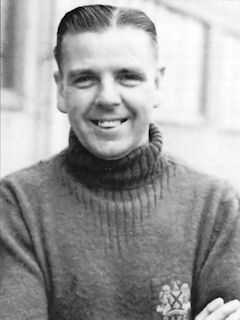
Bill Shortt, PAFC 1946-1956
After that heavy defeat and with no points so far in 1956, the lowest crowd of the season to date, just over 10,000, saw Neil Langman score a hat-trick in an impressive 4-0 win at home to Liverpool in the second week of February. Two desperately welcome wins in early March - 3-0 at home to Barnsley and 2-1 away at Middlesbrough - helped boost the crowd back to nearly 20,000 to see a point against their nearest rivals, Notts County, and the gap had been reduced to one point. But just when there was real hope came four successive defeats, including three over four days at Easter, to leave the Pilgrims five points behind with three to play. It was a particularly sad time for Welsh international Bill Shortt, who on Easter Monday played his 374th and last game in goal for Plymouth Argyle, after a loyal ten years that stretched back to the first season after the war.
On Saturday 7th April, Argyle faced Bury at Gigg Lane, knowing that a win was essential for survival. But the signs were not good: third-choice Peter Dyer was back in goal and regulars Ralph Wetton, Neil Langman, Eric Davis and Charlie Twissell all missed the game. The result was a shock, even by that season's standards: 7-1 to Bury, or as the Western Independent put it, a seven goal slaughter. Argyle had been relegated with two games to spare, but with the pressure lifted, they finished the season with a home win and an away draw. The attendance for that last home game was a measly 6,661, so less than a third of the gate for the first home game of the season had turned out to say goodbye to the Second Division.
And the reasons? Peter Anderson's broken leg in September was an early blow and undoubtedly a major factor; he was a young and talented winger who was sorely missed. Manager Jack Rowley was only fit for 16 games - his top-flight experience was also badly missed - and there were many other injuries throughout the season, with the quality of the reserve players generally insufficient to plug the gaps. Supporters and the newspapers had called for new signings but with the club struggling to manage its debts, the board of directors were unable to fund any significant deals. Developing the club's youth was the only way forward, but that was for the longer term.
1956-1957: THE THIRD TIER FOR THE THIRD TIME
The Pilgrims' second spell in the second tier began in 1952 with a record-equalling fourth place finish before the slow, three-season slide - 19th, 20th, 21st - to relegation. So it was back to the third tier for the third time, with games against Exeter City and Torquay United to add some local interest. But surely the Pilgrims were a Second Division side, as they had been for 17 of the previous 19 conventional league seasons. Surely they would bounce straight back.
Whatever the prospects were on the pitch, the club was in dire straits off it. The club owed the bank £23,500 and there was no prospect of a further loan to fund the £5,000 required to survive the summer. As the old season closed, the club issued a plea to local businesses, one proposal being a scheme to sell 12-feet-long advertising boards that would be attached to the railings around the pitch, at £30 for the season or £100 for five years. Surely that idea would never catch on.
In a desperate attempt to save money, nine full-time professionals were released and two more wanted to leave. Amongst those released were two old-timers, Bill Shortt and Paddy Ratcliffe, leaving only two regulars from the 1952 promotion-winning side: Pat Jones and Neil Dougall. Jack Rowley faced a huge challenge, to build another promotion winning team but with hardly any capital resources.

Mr Ron Blindell
Near the end of May, having put over £2,000 more of their own money into the club, the board received an offer from a successful West Country businessman to invest £3,000 on very favourable interest-free terms, on condition that he was made a director. The offer came from the millionaire owner of a shoe company, Mr R. J. R. Blindell, who was also the president of the South Western League and a former director of Torquay United. However, the proposal did not win the support of every director, as was required, and instead the board launched a public appeal for donations, stressing that £1 per supporter would solve the club's financial difficulties. The appeal notice was a long and sombre affair, ending with the words, "Is Argyle worth a pound to you? You will miss Argyle! Will you miss a pound?"
More bad news came over the summer months. The company balance sheet showed liabilities of £52,000, twice the sum owed to the bank, and one of the newer directors resigned. In an interview for the Western Independent, Mr Cecil Howett said, "It is about time that the public realised that being a director means one long, continual headache and worry. It is a thankless task, the only reward being an endless stream of abuse and criticism. To be an Argyle director in these times of financial hardship one must have no feelings and be completely immune from Press and public criticism. The long and short of it is that I am just not made that way."
Not for the first time in the fifties, the club's AGM in the week before the start of the season was a stormy affair. At their own AGM a week before, the Shareholders' Association resolved to nominate Ron Blindell as an additional club director, a move that won the day at the club's AGM. Also appointed as a director was Mr George Gillin, a former chairman at Torquay United and later a director at Exeter City, and who served on the Torquay board with Ron Blindell.
The season could hardly have got off to a worse start: five games, no points, three goals scored and a whopping 19 conceded, including a 6-0 defeat at home to Reading. Five games into the season, the just-relegated Pilgrims were bottom of Division Three South, with Exeter City one place above them and at the other end of the table, Torquay United in top spot. Perhaps the instability off the pitch had affected morale in the dressing room, but a probable factor was the desperate need for an experienced goalkeeper, with Bill Shortt retired and Les Major's long-term injury probably career-ending. The answer came with the signing of 32-year-old Harry Brown from Queens Park Rangers at the end of August. His first game was the last of those first five matches, a 4-1 defeat at Newport, but he had only been a Pilgrim for four days. A win and two draws in the next five days took the pressure off in early September, with the new shot-stopper appearing to be the answer to the club's on-field problems.

A new form of transport for the season: a coach rather than inflexible train travel. From left to right: Rex Tilley, Johnny Williams, Charlie Twissell, Neil Langman, Reg Wyatt, Alastair Kerr and Peter Langman. Kerr, by the way, played for the Reserves and travelled on this trip as a 'spare'. And if the AFC looks odd, it was sometimes used instead of FC to reflect association football rather than rugby.
Having pulled themselves off the bottom spot, Argyle bounced around in the bottom three in the next two months before finding themselves back at the foot of the table at end of October. The first local derby of the season was a bottom versus top affair, which ended goalless at home to Torquay. A week later there was another derby, this time in the first round of the FA Cup at Exeter, where Argyle put on their best display of the season so far to win 2-0. Then came three very welcome league wins in a row, although those six points only pulled Rowley's men up to second from the bottom. Also in that league sequence was the second round of the FA Cup, which coincidentally turned out to be another Devon derby, Argyle's third in four weeks. This time it was at Plainmoor, where Argyle narrowly lost 1-0.

A glimpse of the first half of the abandoned game against Newport County. The sign above the exit said 'No Money Refunded' for the sparse and very wet crowd.
At its AGM before the start of the season, the Football League decided to allow the use of floodlights for part or all of a match, provided that both sides agreed (before then, floodlights could only be used for friendly matches). That moment in Argyle's history came on December 15th 1956 when the Saturday match against Brentford was scheduled for 3.15 pm rather than the customary 2.30 for a midwinter fixture. Unfortunately, only 6,203 fans turned out to see the Pilgrims win 2-0 that afternoon because of 50 mph winds and torrential rain. That was the third of the three consecutive league wins and also notable for completing nine hours of football whilst conceding just one goal.
There were similar conditions a fortnight later, but this time the referee abandoned the game at half-time (with Argyle beating Newport County 1-0) because, as well as a quagmire of a pitch, the rain had obliterated parts of the touchlines. Between those two very wet Saturdays was Christmas Day and originally a local derby at home to Exeter City. However, as both sides had been knocked out of the FA Cup, the game was rearranged for third round day on January 5th to give the players a rare Christmas afternoon with their families. (A match on Christmas Day had been a traditional event in the football calendar; the last one took place later that year.) The Pilgrims beat the Grecians 5-0, their largest ever win against their Devon rivals, but unfortunately in front of less than 10,000 because of yet another wet and windy Saturday. The result that day took Argyle off the bottom spot.
Another impressive victory came in early February when Neil Langman bagged a hat-trick in a 4-1 win at Coventry City. Langman scored four times in an injury-affected first half of the season, but then 14 in the second half, when he was ever-present, which demonstrates very well his importance to the side. The second highest goalscorer was Eric Davis with 11, but eight of his goals were scored in a run of six games midway through the season.
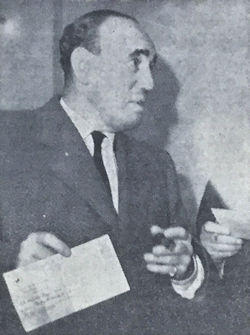
Ron Blindell, characteristic cigar in left hand, waves a cheque for £30,000.
Compared with the previous three campaigns, the season ended without too much angst. Argyle had climbed very slowly up the table to finish in 18th place, but it was also the lowest position in the club's Football League history. In the boardroom, the financial crisis continued to threaten the club's very existence. The public appeal at the start of the season had a very limited effect, and whilst Ron Blindell's £3,000 donation kept the wolf from the door, attendances that were on average 5,000 less that the previous season only exacerbated the already desperate situation. In January the chairman, Sir Clifford Tozer, announced that his board were considering a wide range of remedies and did not discount a take-over if one should be proposed. In February the press reported that 'a well-known Westcountry businessman' had pledged £30,000 to re-finance the company, with three existing directors, Messrs Blindell, Deans and Pengelly nominated to act on his behalf. The businessman's name was never revealed, but it was assumed that Ron Blindell was the mystery man behind the move, although he denied it at the time. The deal required Sir Clifford and his existing board to resign en bloc, and whilst there was some initial resistance, including concerns from Archie Cload, a director, major shareholder, and influential supporter for over 30 years, the deal was unanimously agreed at a board meeting a week later, and then confirmed by the shareholders in April.
As the season drew to a close, Plymouth Argyle Football Company Ltd formed a new board of five directors, with Ron Blindell as its new chairman. Acknowledging his long service to the club and nearly 20 years as its chairman, Sir Clifford Tozer was given the role of club president, and the remainder of the old board were made vice-presidents. There is more about Sir Clifford in Chapter 15.
Ron Blindell, hardly known before the start of the season, was now in full control, and one of his first actions was to end Jack Rowley's playing days by awarding him a new manager-only contract. Whatever lay ahead, there was little doubt that Blindell ran the show and a new era had begun.
Greens on Screen is run as a service to fellow supporters, in all good faith, without commercial or private gain. We have no wish to abuse copyright regulations and apologise unreservedly if this occurs. If you own any of the material on this site, and object to its inclusion, please get in touch using the 'Contact Us' button at the top of the page.
